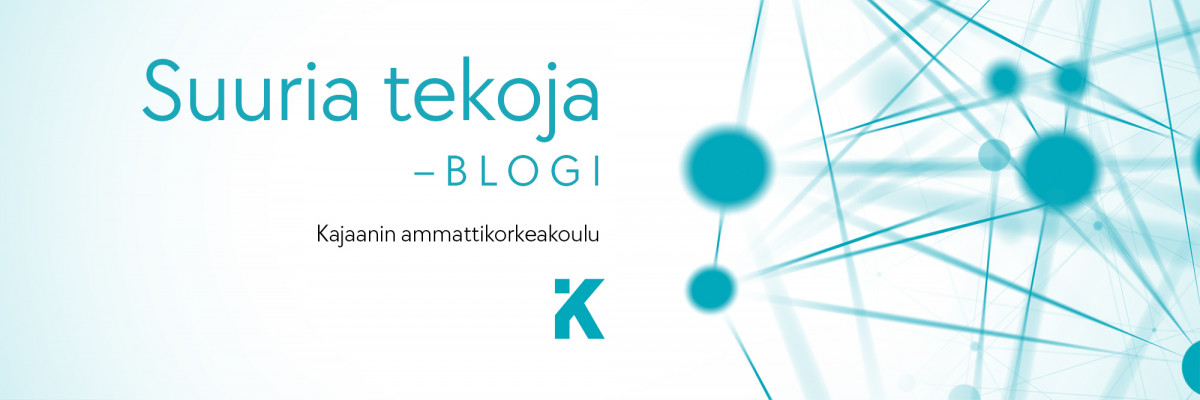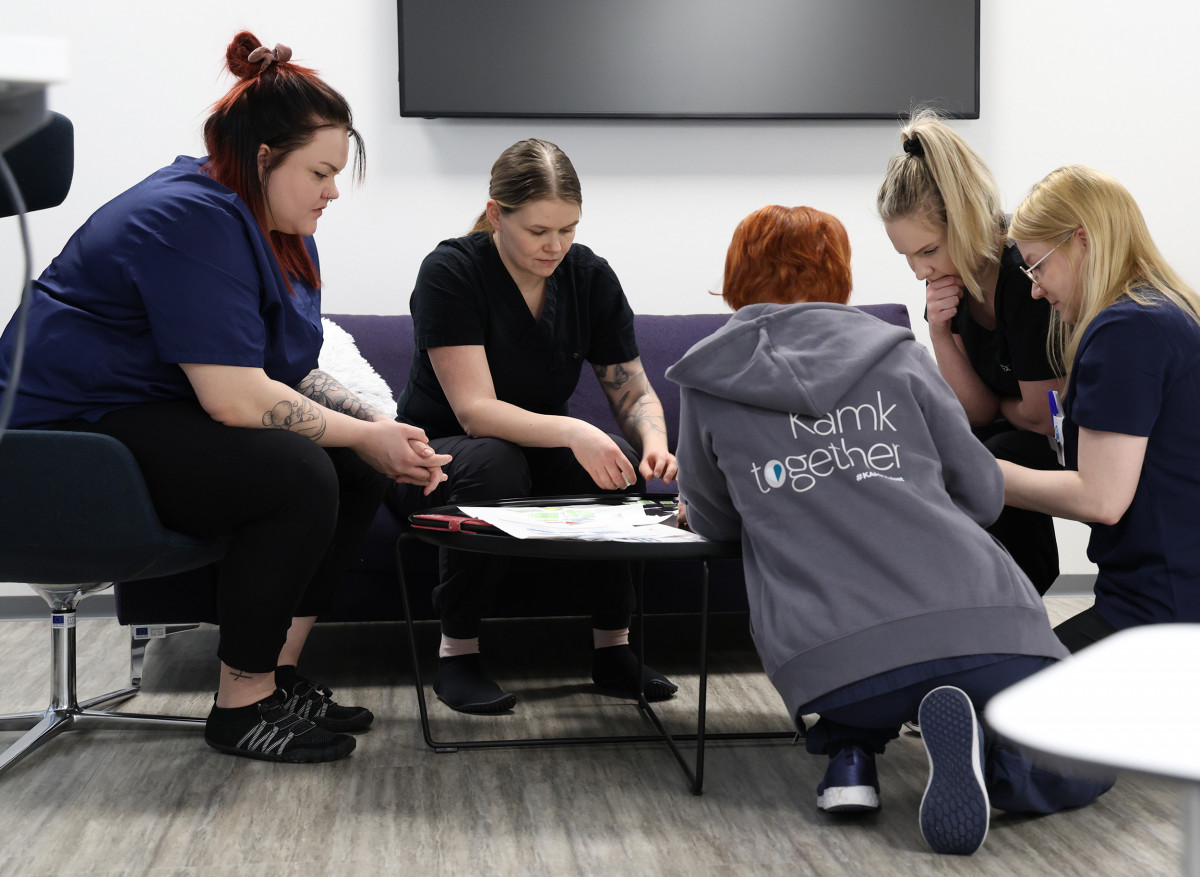The multi-modal education of nurses enables students to study for the profession in their own hometown, when teachers come from Kajaani to the students. This has been an important part of KAMK’s nursing education for almost twenty years, and the importance of these so-called satellite education programs only seems to increase in the future. The nursing education implemented off-campus is structured the same as the Kajaani student groups, but the implementation has its own interesting features.
New nurses are needed
As everywhere in the world, there is a severe shortage of nurses throughout Finland and new, skilled employees are really needed (Haakenstad etc. 2019; STM 2023). According to Orpo’s Government Programme, the important role of universities of applied sciences is to develop the vitality of the regions and to respond to the need for working life (Government Programme 2023). The situation is particularly challenging in small towns outside growth centers. However, for those considering nursing studies, it may be a challenge that studying far from home is not possible, for example due to family reasons. In such cases, the opportunity to study in or near one’s hometown offers a solution that benefits both the individual and society.
KAMK has been organizing nursing education outside Kajaani since 2006. At that time, nursing education was started in Kuusamo, where the sixth education will start in the autumn of 2025. Education has also been implemented in Kuhmo, Suomussalmi, Raahe and Pyhäjärvi. The need for organizing education always comes from the region and education is planned in close cooperation with the actors in the region. At the same time, available teaching facilities, internships and key contact persons are also investigated. Effective cooperation and smooth interaction are indeed a prerequisite for organizing education in satellite locations.
Far from campus
The 210-credit nursing degree is a training course that is strictly regulated by EU directives, among other things. In addition to theoretical studies, the degree includes a large part of clinical competence, i.e. the practice of so-called manual skills and “real nursing work”. This is what is strongly focused on in face-to-face teaching. When the training is carried out outside the walls of an educational institution, things must be considered in the organization of teaching in a different way than in a familiar environment on campus. Authentic nursing equipment is used in the teaching and usually must be taken to the location with the teachers. So, you must think carefully about what equipment is needed for the lessons, nothing can be forgotten. When you have a lot of supplies to transport, you can’t go on a trip in a very small car. In addition, you must consider, for example, weather conditions: infusion bags cannot be stored in the car for long periods of time in freezing or extremely hot weather, and the equipment must not get wet when being moved in heavy rain.

Is everyone included? Yes, and the journey to the remote location can begin at dusk. Photo: T. Romppanen.
All sorts of things happen and happen on teaching trips. Finding spaces and figuring out distances can be challenging. The teaching spaces in use can sometimes be very “creative”, for example a dining hall or a coffee room, a municipal council hall or a hospital conference room. They may not have the same technology, network connections or IT support as on campus. This means that teachers are required to be innovative, flexible and have a touch of humor, they must dare to move out of their comfort zone and work outside the box. They must also always be ready to implement plan B. The essential thing is not the walls and floor, but what is done and how. On the other hand, teaching spaces outside the campus can also be good and authentic, for example a disused hospital ward: quite a luxury!

Get ready! This picture doesn’t show a gym class starting, but rather an injection practice session in the gym. Photo: AL. Luukkonen.
In satellite training, students also can visit KAMK’s Kajaani campus, and these days are important for both students and teachers. They are also quite a hassle, as traveling a couple of hundred kilometers for the entire student group is not easy. This requires arranging transportation, accommodation and childcare, and the days can be long. On the other hand, the days are often a much-needed break from everyday life for students, and both students and teachers enjoy them. It is also not unusual for a baby, for example, to go on a trip with their mother, who is an active KAMK student.

A group of students from Pääjärvi studying on campus. Photo: T. Sirviö.
When teaching is mainly done remotely, online and off-campus, this also presents a positive challenge to how teaching can be implemented in a high-quality, interesting and innovative way. Teachers must therefore have strong digital pedagogical skills. As a solution to the challenges of remote locations, KAMK has developed, among other things, gamification and remote and hybrid simulations.
Remote simulations have been implemented in various ways, for example, where students and teachers have participated in simulations in a remote location and the actual activities have taken place on campus in simulation rooms. Such simulations implemented by the institution’s own teachers in the premises of the university of applied sciences have been felt to be better than viewing ready-made videos, as even the recorded simulations ”implemented by your own team” are perceived as quite authentic. These can also be used to prepare students for face-to-face teaching on campus.
The campus has high-quality video and audio connections for distance learning, but these are not available in remote locations. However, creative methods can be used, if necessary, for example using an iPad.

Creative implementation of hybrid simulation in a remote location: iPad taped to an infusion stand. Photo: T. Romppanen.
Is it worth it?
The students have been mostly very satisfied with the training courses implemented in the satellite locations. They feel that studying close to home makes their lives easier and are grateful that the teachers are on the move, not always the students. This also makes the teachers feel particularly successful and good – this is worth all the effort and that is only a virtue! The students have also generally grouped well and there is a positive atmosphere in the groups. The key to the success of this is effective tutoring and uncomplicated relationships with the teachers. This also means that the teacher is not always the best expert, but the students have the best knowledge of, for example, the local service system or practical matters, such as dining options.
Local authorities are pleased that by bringing education closer, qualified professionals can be obtained to secure healthcare services. When completing internships, students become well acquainted with the working life of their own area and get a foot in the door when applying for a job. Since not everything is always ready-made and routine during their studies, working life skills such as flexibility, problem-solving skills and the ability to act in different situations and settings inevitably develop during their studies. This competence is also needed in the work of a nurse.

Creativity is in the air! The CPR exercise in the conference room is about to begin. Photo: T. Romppanen.
Looking to the future
In 2025, KAMK’s nursing education will continue in Raahe, Kuusamo and Pyhäjärvi. These education programs will once again produce skilled professionals and create new growth stories.
Thanks to modern technology and strong pedagogical expertise, nursing education knows no municipal boundaries and does not require familiar walls around it but can be implemented almost anywhere. KAMK’s satellite education programs produce satisfied and skilled nurses, also in the future. In the future, educational methods and solutions will continue to develop, and this will benefit students, KAMK and our entire Finnish society.
Resources:
Haakenstad, Annie et al. (2019) Measuring the availability of human resources for health and its relationship to universal health coverage for 204 countries and territories from 1990 to 2019: a systematic analysis for the Global Burden of Disease Study 2019. The Lancet, 399, (10341), 2129–2154
Hallitusohjelma (2023) Vahva ja välittävä Suomi Pääministeri Petteri Orpon hallitusohjelma. The permanent address of the publication is http://urn.fi/URN:ISBN:978-952-383-763-8
STM (2023) Sosiaali- ja terveysalan henkilöstön riittävyyden ja saatavuuden turvaaminen, Tiekartta 2022–2027. Publications of the Ministry of Social Affairs and Health 2023:8. Helsinki: STM.

